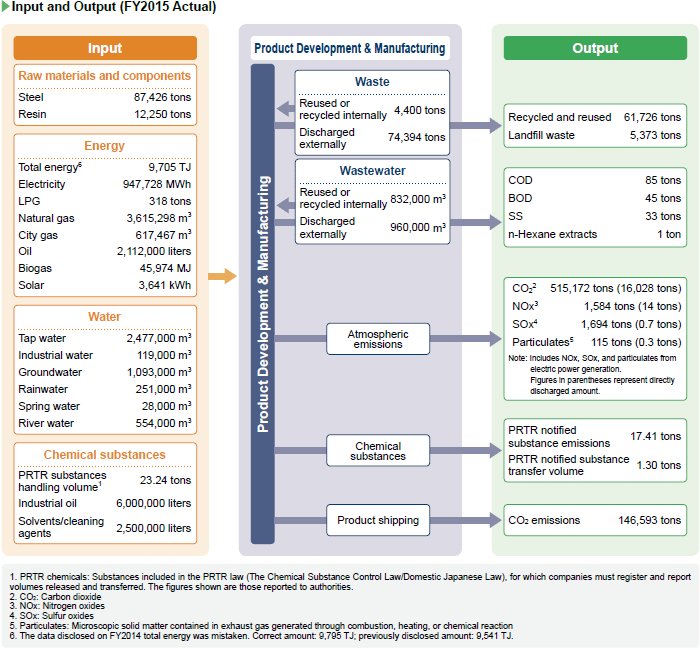Basic Approach
The Minebea Group has established an environmental management system based on the Minebea Group Environmental Policy, and all Group companies are striving to contribute to the protection of the earth’s environment and the sustainable development of human kind.
As examples of specific initiatives in this regard, we adopted highly energy-efficient equipment and processes and set a FY2015 target of reducing total Group CO2 emissions per basic unit of output by 5% compared with the baseline year (FY2010). As a result of our measures, the Group as a whole achieved a 55% reduction in CO2emissions per basic unit of output through FY2015.
We are also strengthening initiatives to minimize waste materials and wastewater from our plants in order to effectively utilize raw materials and water resources. We also make contributions to the environment through our products, including the active development of communications control technologies, sensors and new materials which are central to energy management in highly efficient motors, lighting, and energy conversion devices, as well as “smart” buildings, plants, and urban residential environments.
Minebea Group Environmental Policy
Established August 26, 1993
Revised June 01, 2012
The Minebea Group strives to contribute to the protection of the global environment and sustainable human development. In accordance with the Five Principles of its management policy, the Minebea Group operates its business activities in a responsible manner which respects the environment.
1. Development and design
The Minebea Group will aim to offer its clients products which contain no hazardous substances for the environment or the health and safety of humans, and which consume as little energy as possible, have high reliability and long life. The Minebea Group will develop and design products which minimize environmental impact over their entire life cycle from the selection of direct and indirect materials and component parts through end use to disposal.
2. Manufacturing
For environmentally conscious manufacturing and its continuous improvement, the Minebea Group will improve production yield, reduce product scrap, energy consumption and waste through the 3R concept (Reduce, Reuse and Recycle) and implement preventive measures with regard to pollutants.
3. Procurement and logistics
For environmentally conscious procurement and logistics, the Minebea Group will procure materials including indirect materials and component parts which contain no hazardous substances and employ environmentally friendly logistics systems to minimize environmental impact such as CO2 emissions.
4. Cooperation with authorities and local public entities
The Minebea Group will observe applicable environmental regulations and rules in the countries and local communities where it is engaged in business. The Minebea Group will contribute to society through participation in its environmental conservation activities.
5. Contribution to the international community
The Minebea Group will make public its environmental conservation technologies to contribute to the international community’s environmental activities. The Minebea Group will also recognize that its business activities may have an effect on biodiversity and ecosystems and will work to conserve nature.
6. Enhancement of environmental conservation awareness among the Minebea Group employees
This environmental policy will be published to the whole Minebea Group. Each employee will be expected to work proactively to conserve the environment.
Environmental Management Structure
In order to carry out the Minebea Group Environmental Policy, the Minebea Group has established an environmental management structure headed by the Board of Directors and the President and Chief Executive Officer. We have also put in place an Environment Management Committee, a promotion organization composed mostly of executive officers, and a Group Environmental Protection Committee, which leads the day-to-day execution of policy. This structure enables rapid response to environmental policy. Each work site also has a Plant General Manager of Environmental Management and a Manager of Environmental Management who promote specific environmental conservation measures at their work sites.
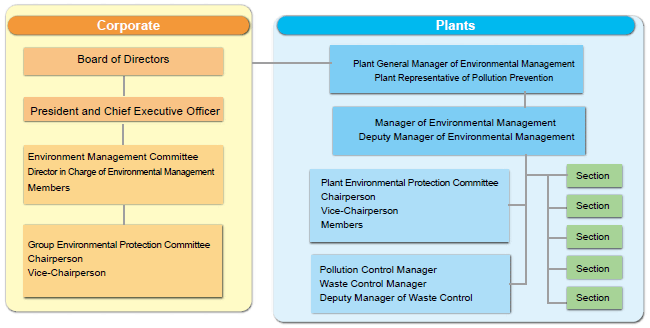 Environmental Audits
Environmental Audits
The Minebea Group is striving to acquire ISO 14001 certification at each of its major global sites. To maintain certification, we also conduct annual external audits by third-party organizations and internal audits by internal auditors. In FY2012, Minebea Electronic Devices (Suzhou) Ltd., Minebea (Cambodia) Co., Ltd. and the Daiichi Seimitsu Sangyo Co., Ltd. headquarters newly acquired certification. Additionally, we began preparations to acquire ISO 14001 certification for the Tokyo Head Office in conjunction with the office’s relocation.
Environmental Education
Basic Approach and FY2015 Initiatives (Japan)
The Minebea Group provides fundamental environmental management education to all new employees, midcareer hires, trainees, returnees from overseas assignments, and other employees in order to raise the environmental consciousness of each employee.
Additionally, all employees receive environmental management education covering the Minebea Group Environmental Policy, along with environmental targets and action plans based on each site’s ISO 14001. Educational programs also cover waste separation and training drills for responding to emergencies.
FY2016 Environmental Education and Training Plan (Japan)
| Plan No. |
Training item | Recipients | Description |
|---|---|---|---|
| 1 | Environmental management basics training | New university graduates hired by Group companies | Collective education for all newly hired employees |
| 2 | Environmental management basics training | New university graduates hired by business site | Collective training for new employees hired by business site Environmental policy, plant goals, implementation plan, environmental management organization, environmental committee role, etc. |
| New university graduate employees assigned to each division ISO 14001 activities undertaken in assigned division |
|||
| 3 | Environmental management training | All employees | Training mainly about ISO 14001 activities undertaken in assigned divisions Environmental policy, environmental aspects, environmental goals, implementation plan, legal and other requirements, etc. |
| 4 | Training for mid-career hires, reassignments, overseas returnees, trainees, and temporary employees |
Mid-career hires, reassignments, overseas returnees, trainees, temporary employees |
2. Environmental management basics training 3. Environmental management training 6. Waste management education 7. Training focused on daily work activities in consideration of training drills for emergency response |
| 5 | Training for employees engaged in specific types of work | Employees engaged in specific types of work | Appropriate training enabling employees to gain the ability to do specific types of work |
| 6 | Waste management education | All employees | Training on appropriate methods of separating waste |
| 7 | Emergency response training | All employees | Facility and work training simulating emergencies caused by natural disaster or human accidents |
| 8 | Education and training deemed necessary by each site | All employees | Training and education that is not covered by other types of training, for example hazardous materials management |
| 9 | Internal auditor training | Employees requiring training |
|
| 10 | EMS awareness training | All employees |
|
| 11 | Subcontractor and internal subcontractor training | Subcontractors Internal subcontractors |
Training on Minebea’s environmental programs for subcontractors and internal subcontractors |
| 12 | Training through external lectures and programs | Employees requiring training | Lectures and training as needed for employees to acquire certifications Legal and other seminars |
Publication of the Minebea Group’s In-house Environmental Newspaper “Hello Environment!”
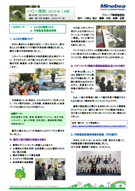
Group environmental newsletter “Hello Environment!”
The Minebea Group publishes the in-house environmental newspaper “Hello Environment!” which focuses on a particular educational theme each month through easily understood, instructive articles. The newspaper is delivered to Group employees.
The content includes not only articles on the Group’s environmental activities, but practical information on the environment and daily lifestyles. The Group’s first environmental newspaper was published by the Hamamatsu Plant in January 2000 as the plant’s own newspaper, and through the March 2016 edition of the Group’s in-house environmental newspaper, a total of 190 editions had been published.
ISO 14001 Internal Auditor Training (Japan)
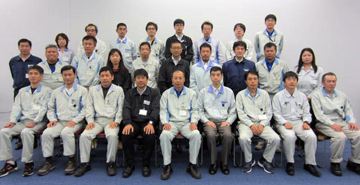
ISO 14001 internal auditor trainees and instructors for fiscal 2015
To nurture a corps of ISO 14001 internal auditors, the Minebea Group has conducted training 16 times between FY1999 and FY2015 and certified an accumulated total of more than 300 internal auditors.
The training sessions are led by employees with external ISO 14001 auditor certification and focuses on giving trainees the knowledge and skills necessary to become internal auditors. Training candidates are nominated by each domestic plant. Training consists of lectures to gain basic knowledge, simulated audits and group discussions, followed by a written test. Successful trainees are certified as internal auditors based on an overall evaluation of their attitude, the quality of their audit reports, and their scores on written tests.
Initiatives to Protect Biodiversity
Basic Approach
In FY2012, the Minebea Group revised its Environmental Policy and added “contribution to the international community” as a new initiative. As part of the initiative, we recognize that our business activities may have an effect on biodiversity and ecosystems, and we will work to conserve nature. As a first step, recognizing the importance of understanding the impact of our business activities, we are conducting research on how the Minebea Group’s business relates.
Participation in Wildlife Sanctuary Reforestation Project (Thailand)

NMB-Minebea Thai employees take part in a tree-planting campaign
A group of 135 employees from NMB-Minebea Thai joined 20 teachers and students from Banratbamrung School to plant trees in the Sublungka Wildlife Sanctuary, Lop Buri Province. The volunteers planted 100 trees, while also building an irrigation canal and dams. The company also made a donation of books and stationary to support school activities.
The objectives of the activity were to:
- Build good communication with the community through the activities
- Increase employee awareness and understanding of the importance of forest preservation
- Restore biodiversity to the forest and protect wildlife food sources
- Prevent global warming
Environmental Communications
Basic Approach
So that as many people as possible may become aware of the Minebea Group’s initiatives to preserve the environment, we publicize those initiatives and their results on the Internet and through a variety of means including CSR reports, company brochures, and annual reports. We also actively take part in regional activities and create opportunities to introduce the Minebea Group’s environmental initiatives to the public.
Waste Separation Workshops for Local Children (Thailand)
NMB-Minebea Thai hosts workshops to teach local children about waste separation as a way to raise their awareness of the environment and promote a better understanding of waste separation. In August 2015, the company held a workshop for a total of 344 students, from fourth-grade elementary school students through third-grade junior high school students, at the Chonpratan Anukroh School in Ayutthaya Province. In March 2016, another workshop was held for students at Wat Pued Nimit School in Pathumthani Province, comprising 52 elementary school students from the fourth to sixth grades, along with 66 junior high school students from the first through third grades.
Through quizzes, games and other activities, students learned about waste problems in Thailand, the impact of improper separation methods, the disposal and recycling of waste, and the benefits of waste management.
 Waste separation workshop at Chonpratan Anukroh School
Waste separation workshop at Chonpratan Anukroh School
Environment One-click Fund-raising (Fujisawa Plant)

“Donation” icon for the Fujisawa City Environment One-click Fund-raising initiative
The Minebea Group’s Fujisawa Plant, located in Fujisawa City, Kanagawa Prefecture, collaborates with local government, enterprises, and residents to carry out Fujisawa City Environment One-click Fund-raising, an initiative created in response to current environmental problems, exemplified by global warming.
The goal of this initiative is to raise local residents’ environmental awareness, publicize the social contributions of participating enterprises, and enhance environmental education for children—who will become the next generation of adults. The Minebea Group has participated in this initiative since July 2009. Fund-raising takes place simply by clicking the “Donation” icon on the participating enterprise’s environmental activity-related web page. For each click received, the participating enterprise contributes five yen on behalf of that person. The funds collected go to provide Fujisawa City schools with teaching materials relating to the environment.
During FY2015, a total of 100,000 yen* for 41,889 clicks was contributed on behalf of visitors clicking the fund-raising icon on the Fujisawa Plant’s environment-related web page.
* The maximum corporate donation for the Fujisawa City Environment One-click Fund-raising project is ¥10,000 monthly and ¥100,000 annually.
Minebea web page with link for the Fujisawa City Environment One-click Fund-raising initiative![]()
Wastewater Processing Facilities Tour for Local Residents (Thailand)

Chiangraknoi area residents tour the Bang Pa-in Plant’s wastewater processing facilities
NMB-Minebea Thai’s Bang Pa-in Plant welcomed 30 people from the nearby Chiangraknoi community to tour the wastewater processing and rain water recycling facilities and better understand the plant’s wastewater processing systems.
By the end of the tour, the participants had formed a better understanding of the plant’s wastewater processing and water conservation initiatives, as well as the “Plant Wastewater Zero System” in which plant wastewater is recycled internally to the extent possible. This made for a satisfying event for everyone.
Support for Tree-planting on National Arbor Day (Thailand)
Ten employees from NMB-Minebea Thai’s Rojana Plant participated in tree-planting and stocked 10,000 fish with local residents at nearby Wat Kanham Temple on Thailand’s National Arbor Day.

Tree-planting ceremony and activities
Cleanup Activities around Plant Site (Cambodia)
Approximately 1,900 employees of Minebea Cambodia collected garbage during a cleanup event on June 30, 2015, around the plant site in Phnom Penh Special Economic Zone as a way to contribute to the beautification of the local community.

Cambodia Plant employees volunteer for community cleanup
Participation in Nakaumi and Lake Shinji Cleanup Campaigns (Japan)
Forty employees of the Minebea Yonago Plant pitched in to help with a cleanup campaign aimed at protecting the ecosystems of Lakes Nakaumi and Shinji. Stretching across the borders of Tottori and Shimane Prefectures, the lake sites are included in the Ramsar Convention’s List of Wetlands of International Importance. The cleanup campaign, run by Tottori and Shimane Prefectures as well as five lakeshore municipalities in the area (Yonago, Sakaiminato, Matsue, Yasugi, and Izumo), is held every June. About 8,000 people participated this year, picking up a total of 15 tons of trash. Despite being the middle of the rainy season, the sun shone down on everyone that day as they worked up a good sweat for a great cause.
Ramsar Convention: A treaty protecting wetlands of international importance which serve as waterfowl habitats

Employees take part in the cleanup campaign
Commuting Route Cleanup (Japan)
As part of the Environment Month activities, employees of the Karuizawa and Matsuida plants volunteered to clean up commuting routes on June 17, 2015. At the Karuizawa Plant, 60 employees collected 1.8 kg of garbage. At the Matsuida Plant, 30 employees collected 12.5 kg of garbage.
 Employees clean up commuting routes
Employees clean up commuting routes
 Collected garbage
Collected garbage
Participation in 20th Fujisawa Environment Fair (Japan)

Each year, Fujisawa City holds the Fujisawa Environment Fair attended by municipal organizations, schools, companies, and local residents. The Fujisawa Plant exhibited for the first time at the 20th annual fair held November 21, 2015. The Mayor of Fujisawa and other government representatives visited the Minebea booth, where Mr. Hideo Asakawa, Head of Fujisawa Plant , and others explained the exhibit. Families with elementary-aged children also stopped by the booth, giving many local residents an opportunity to learn about Minebea’s products and environmental conservation activities.

Opening ceremony for the Fujisawa Environment Fair and Minebea’s booth
Minebea’s Environmental Accounting
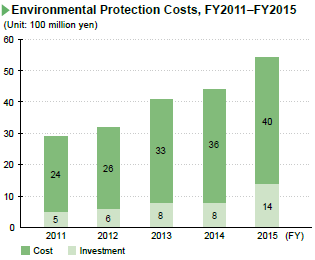 The Minebea Group conducts environmental accounting to confirm its costs for environmental protection activities and the effect of its investments. The Japanese Ministry of the Environment’s Environmental Accounting Guidelines 2005 is used as a reference. The Minebea Group’s environmental conservation costs totaled 5,416 million yen in FY2015, a 22% increase over FY2014.
The Minebea Group conducts environmental accounting to confirm its costs for environmental protection activities and the effect of its investments. The Japanese Ministry of the Environment’s Environmental Accounting Guidelines 2005 is used as a reference. The Minebea Group’s environmental conservation costs totaled 5,416 million yen in FY2015, a 22% increase over FY2014.
FY2014 Environmental Conservation Costs
| Environmental Protection Activity Costs | Total | ||||
|---|---|---|---|---|---|
| Category | Activity | Investment | Expenses | ||
| 1 | Costs to minimize the environmental impact from manufacturing and service activities within the business area | As set forth in breakdown for (1), (2), and (3) | 1,432 | 3,018 | |
| (Business area costs) | |||||
| Breakdown | (1) Pollution prevention costs | Costs related to installation, disposal, operation, maintenance, management, etc. of facilities to prevent water and air pollution | 198 | 510 | |
| (2) Environmental protection costs | Costs for installation of ozone-depleting substance (ODS)-free water-based cleaning facilities, high-efficiency refrigerators, depreciation, operating and maintenance costs, etc. | 1,005 | 1,744 | ||
| (3) Resource recycling costs | Equipment and costs for waste disposal and recycling | 229 | 764 | ||
| 2 | Costs to reduce environmental burden in upstream and downstream processes caused by manufacturing or services activities | Costs related to analyzer installation and materials analysis as part of the Green Procurement Program; printing and revenue stamp costs for contracts with suppliers, etc. | 9 | 98 | |
| (Upstream/downstream costs) | |||||
| 3 | Administrative activity-related environmental conservation costs (Administrative costs) | Personnel, maintenance and management costs for environmental management system, etc. | 2 | 367 | |
| 4 | R&D activity-related environmental conservation costs (R&D costs) | Costs related to the research and development of water-based cleaning facilities, etc. | 0 | 1 | |
| 5 | Community activity-related environmental conservation costs (Community activity costs) | Costs related to greening programs, landscape preservation, etc. | 0 | 7 | |
| 6 | Environmental remediation-related costs (Environmental remediation costs) | Costs related to soil replacement and operation, maintenance and depreciation of water-based cleaning facilities for the remediation of soil | 5 | 477 | |
| (Environmental remediation costs) | |||||
| Total | 1,448 | 3,968 | |||
1USD=¥120.8 1EUR=¥132.8 1THB=¥3.5 1CNY=¥19.0 1SGD=¥87.1 1GBP=¥182.2 1MYR=¥30.1 1PHP=¥2.6
Minebea’s Environmental Impact
The Minebea Group has plants in 15 countries around the world, manufacturing and selling a range of products including bearings—our main product—as well as machined components and electronic devices. When environmental impact is viewed in terms of the ratio of total production by region to sales, Asia (excluding Japan) is estimated to account for approximately 80% of the Minebea Group’s consumption and output.
In FY2015, even though our sales increased by 22% year on year, our total energy consumption declined by 1% year on year, the amount of industrial oil remained about on par with the previous year, and the increase in the amount of solvents and cleaning agents was limited to 9% year on year, reflecting our ability to restrain our impact on the environment relative to the amount of sales.
The Group’s environmental impact for FY2015 is summarized below.
